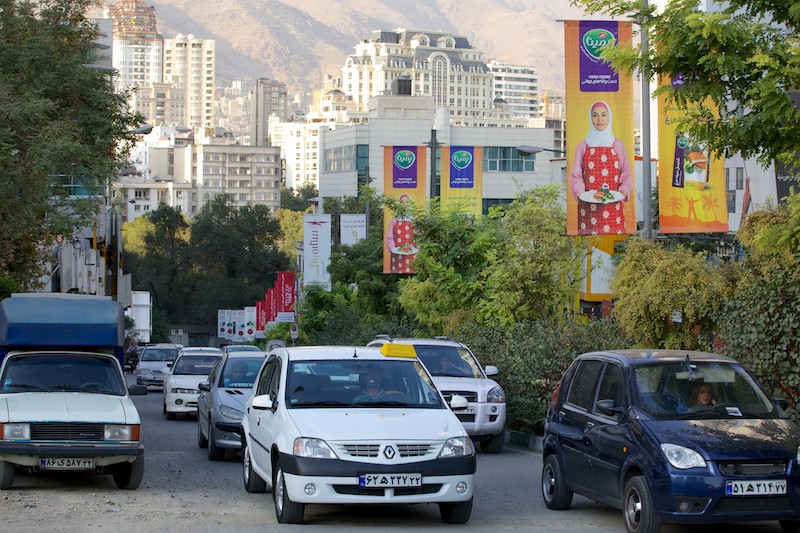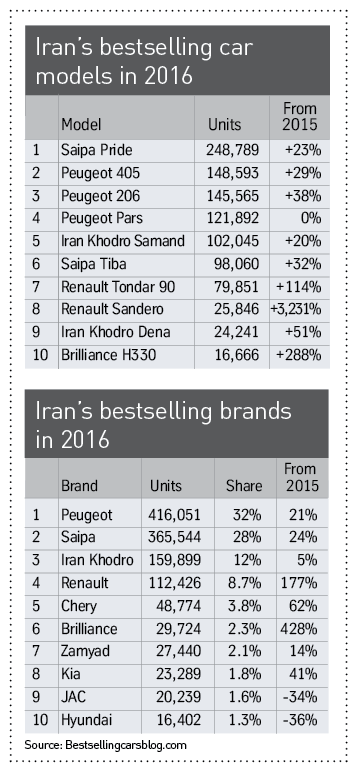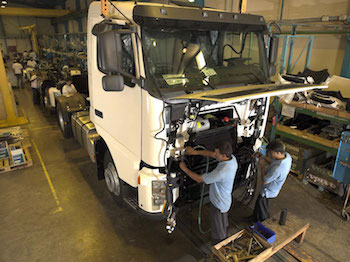Violent unrest and economic uncertainty continue to rack the Middle East, but automotive production is booming thanks to the liberation of demand in Iran, the biggest consumer of vehicles in the region
 Up until they were lifted in early 2016, Iran suffered heavily under the yoke of nuclear-related economic sanctions imposed both by Europe and the US, particularly those dating from 2012. However, since then, the country has seen production and sales of vehicles rise, prompting the return of foreign vehicle-makers, led by the French, eager to either resume previous joint ventures with Iran’s dominant state-led companies or to forge new agreements.
Up until they were lifted in early 2016, Iran suffered heavily under the yoke of nuclear-related economic sanctions imposed both by Europe and the US, particularly those dating from 2012. However, since then, the country has seen production and sales of vehicles rise, prompting the return of foreign vehicle-makers, led by the French, eager to either resume previous joint ventures with Iran’s dominant state-led companies or to forge new agreements.
Iran boasts the second-largest population in the Middle East at around 82m and the biggest vehicle market, with car sales rising 25% last year to 1.28m according to global car sales aggregator Bestsellingcarsblog.com. With imports of mainstream cars discouraged via high taxation, this has boosted local vehicle production, which stood at 1.16m last year, up 19%, according to figures from global vehicle trade association OICA, around 90,000 of which were medium or heavy commercials.
A check of the bestseller charts gives the impression that Peugeot is the dominant carmaker in the region, but all of its 400,000-plus cars sold last year were built under licence by Iran Khodro, which along with SAIPA is responsible for the production of around 80% of cars sold in the country. Both makers are part-owned by the largest company in Iran, the government-run Industrial Development & Renovation Organization of Iran (IDRO).
"Iran Khodro, along with SAIPA, is responsible for the production of around 80% of cars sold in the country. Both makers are part-owned by the largest company in Iran, the government-run Industrial Development & Renovation Organization of Iran (IDRO)"
IDRO is slowly divesting itself of the two companies and now owns 15% of Iran Khodro (khodro being the Iranian word for car), and 36% of SAIPA, but the duo’s grasp on local production is such that the automotive industry here can safely be described as an oligopoly.
SAIPA, which kicked-started automotive production in Iran with Citroën Dyane-based models in the 1960s, makes last year’s bestselling car, the Siapa Pride, a supermini sold with myriad body styles including a pick-up, all based on the 1990s Kia Pride.
The giant company has around 100 subsidiaries and affiliates, according to its website, and builds Renaults under licence as well as trucks for Iveco, Volvo and Renault Truck. It has forged partnerships with Chinese makers in recent years and produces cars for Brilliance and Changan as well as trucks for Dongfeng and Foton. SAIPA’s subsidiaries build a wide range of parts including engines, gearboxes, dashboards, seats, shock absorbers, springs and radiators.
Iran Khodro’s big models are the Peugeot 405 and very similar Peugeot Pars, Iran’s second and third bestselling cars last year. It also builds the Peugeot 206 supermini, the Renault Tondar small saloon (as does SAIPA, curiously) and a range of own-brand cars based mainly on old Peugeot platforms, the bestselling model of which is the Samand.
Also known as IKCO, Iran Khodro is perhaps most famous for its long-running production of the Paykan, a rebadged version of the British Hillman Hunter, which ended production in Iran in 2005. The company has eight vehicle production plants with a capacity of around 1.3m, meaning that it suffers from overcapacity.

New agreements with the FrenchAny overcapacity might be cured by new agreements signed with PSA Peugeot Citroën last June, which will see Iran Khodro producing new Peugeots under a 50:50 joint venture with PSA. Meanwhile SAIPA will produce new Citroëns, again in a 50:50 joint venture (instead of under licence). This brings PSA back to the country after it was forced to leave because of the EU sanctions.
The Iran Khodro deal will see the joint-venture company invest “up to” €400m ($470m) to 2021 according to PSA, both in manufacturing and R&D. It brings brand-new models into production, including the Peugeot 208 supermini, 2008 supermini SUV and 301 small saloon. Iran Khodro will also develop a new vehicle using the Peugeot platform underpinning these cars. A Peugeot spokesperson told AMS that the JV had already built 16,000 of the 2008 as of the end of July, with sales beginning later this year.
Citroën’s joint venture with SAIPA will see the new company invest “more than” €300m in manufacturing and R&D by 2021 and it will produce three new, unnamed models, “adapted for the Iranian market” according to Citroën, at a plant in Kashan, 250km south of the capital, Tehran. SAIPA opened a new plant there in 2010.
Meanwhile, Renault last year announced a joint venture with government-owned company IDRO (the one that has a share in the two dominant Iranian vehicle producers), with the French maker as the majority shareholder. The resultant operation will build a new plant with an annual capacity of 150,000 units as well as an engineering and purchasing centre for an undisclosed investment. It plans to start building the Symbol supermini saloon and Duster small SUV in 2018. This would take the French OEM’s capacity to 350,000 in the country, including the deals with Iran Khodro and SAIPA.
So far, no other foreign carmaker has said that it will set up new production facilities in Iran after the end of sanctions, but VW could be about to take the plunge after it announced in July its return to the market with import models to be sold from August in partnership with Mammut Khodro, a subsidiary of the Dubai-based conglomerate. VW had withdrawn from Iran back in 2000.
Confidence growingThe big push by the manufacturers demonstrates their confidence that the market will grow. Automotive analysts at IHS Markit predict that Iranian car sales will increase from 1.25m last year to 1.55m in 2018 and 1.7m in 2020 before reaching 1.85m in the longer term. PSA has predicted that the market will top 2m but IHS’s analyst for the region, Michel Jacinto, disagrees. “When we look at purchasing power there and compare the GPD per capita with Turkey or South Africa, it’s lower in Iran,” he says.
Some manufacturers remain cautious about investing in Iran because they worry, in particular, that the thaw in relations with the US will not last, especially with President Trump threatening to re-impose sanctions. Indeed, The Economist argued persuasively at the end of July that Trump might get tough on Iran in reaction to being blocked by Congress on easing Russian sanctions.
“We are well aware of the market potential in Iran but we can’t afford to take any risks,” a source close to VW told Reuters in May. “Any company operating in Iran or planning to enter the market needs to ask itself what could happen if there is a fundamental change of course by the US.”
Also wary is Daimler, which signed a deal with Iran Khodro Diesel and Mammut Group to produce Mercedes-Benz trucks and components back in January last year, starting with CKD assembly of the Actros and Axor range of trucks. “The suspension of the sanctions imposed on Iran represents an opportunity,” the company wrote in its annual report published earlier this year, before going on to say that the resumption of local production and sales of trucks was “dependent on the further development of local conditions”. The company told Reuters in May: “There is hardly any economic growth in Iran, so demand for commercial vehicles is generally low.”
Iran’s locally produced vehicles are undergoing a badly needed update in quality after a revolt by consumers. “At the end of 2015, customers were boycotting new cars because they thought the current offerings were poor regarding safety features, comfort and design,” says IHS’s Jacinto. “Many people perceive them as outdated.”
Jacinto believes that Peugeot/Iran Khodro will drop the long-running 405/Par, a bestseller for two decades, within the next two or three years after it introduces three new models. Local media reported earlier this year that on the commercials side, Iran Khodro would stop making the Arisun pick-up, based on (what else?) the Peugeot 405, and also the Mercedes L-series, a tipper truck that started life in 1959 and has been in production for nearly 30 years in Iran.
 The sanctions that kept Western vehicle-makers from upgrading models gave opportunities to the Chinese, which were not restricted from doing business in the country. Last year Chery became the fourth-largest car brand with sales up 62% to 48,774, followed by Brilliance, which saw 428% growth. JAC was ninth.
The sanctions that kept Western vehicle-makers from upgrading models gave opportunities to the Chinese, which were not restricted from doing business in the country. Last year Chery became the fourth-largest car brand with sales up 62% to 48,774, followed by Brilliance, which saw 428% growth. JAC was ninth.
Chery describes itself as the largest private carmaker in Iran after partnering with the Modiran Vehicle Manufacturing Company (MVM) back in 2004, when it started building cars from CKD kits. Chery bought a controlling share in the partnership in 2009 and now has a plant in Bam, 1,000km south-east of Tehran, with an annual capacity of 60,000 units. There are plans to expand this capacity to 100,000. MVM claims to employ 2,500 people at the factory.
The growth of the Chinese OEMs is a problem for the two local makers. “The big challenge is to manage future competition between the Chinese and domestic brands,” explains Jacinto, who adds that, while Iran needs the investment from China, at the same time it has to support Iran Khodro and SAIPA. However, SAIPA, for one, is working with the Chinese, building Brilliance and Changan cars, as well as Foton and Dongfeng trucks.
Slump elsewhereNowhere else in the Middle East comes close to matching Iran in terms of vehicle production, but many are trying to develop their own industry.
Egypt (included in the Middle East for the purpose of this analysis; Turkey is not) is the only country in the region with a greater population than Iran, at around 95m, but recent unrest and poor economic outlook has suppressed the country’s long-standing vehicle production, which last year stood at just 36,230, up 0.6%, according to OICA. Of those, 25,300 were commercials and 10,930 were cars.
Vehicle production started here in the 1960s and expanded when industry was liberalised in the 1980s, which is when General Motors set up an assembly plant in the capital, Cairo.Today, GM builds Chevrolet-badged versions of Chinese Wuling people-carrier style cars designed by its China joint-venture with SAIC. Its plant in the 6th October district of Cairo makes the Move and the Optra. GM has sold its East Africa business to Isuzu as a part of a global withdrawal but so far has not shown signs of off-loading its Egyptian operations, perhaps because of the Wuling connection.
Other makers include the Bavarian Auto Group contract manufacturer, which started out making CKD BMWs but now builds cars for India’s Mahindra and China’s Brilliance, according to its website. Its rival, Arab American Vehicles (AAV), was set up in 1978 as a joint venture between Chrysler and the Arab Organisation for Industrialization (AOI), a military-aligned company that pays no customs duties for imported parts or taxes on its revenue. Its website says that it still makes Jeeps, mainly for military use, but in July this year it started building the Toyota Fortuner, a big SUV based on the Hilux pick-up, at an estimated output of 3,000 a year. Also building cars in the country is Nissan, which makes the Sunny saloon.
Egypt’s automotive success story is the MCV Group, which describes itself as the leader in commercial vehicles in the Middle East and Africa. It claims an annual capacity of 10,000 buses, which are what it is best known for, but can also make 1,500 trucks a year. MCV says that it exports 60% of its production, including double-decker buses to London. The vehicles are mostly adaptations of Daimler commercials.
 Zahid Tractor builds for Volvo Trucks and its subsidiary Renault Trucks on the outskirts of Jeddah
Zahid Tractor builds for Volvo Trucks and its subsidiary Renault Trucks on the outskirts of JeddahSaudi and UAEThe biggest Middle East car markets outside Iran are Saudi Arabia, followed by the United Arab Emirates (UAE), which includes Dubai and Abu Dhabi.
Saudi Arabia is another economy which is being hit hard by the current slump in oil prices and its car sales last year fell 21% to 691,114, according to Bestsellingcarsblog.com. All are imported but the country is trying to strengthen its automotive industry, which currently just makes commercial vehicles. Jaguar Land Rover briefly toyed with the idea of setting up a car factory there before settling on Slovakia, but Toyota could be the first after the company signed a memorandum of understanding with a Saudi government agency in March to investigate producing vehicles there.
It would have to overcome a shortage in skills and supplier network, but Toyota does have the advantage of being the country’s bestselling brand, thanks in part to the success of the Hilux pick-up, the country’s second bestseller last year. The small Hyundai Accent saloon was the most popular.
In terms of commercial vehicles, local company Zahid Tractor builds for Volvo Trucks and its subsidiary Renault Trucks on the outskirts of Jeddah. It claims to have a capacity of 4,000 units a year on a single shift, but neither OEM released figures in their most recent annual reports. That could be because the company is aware that doing business in countries such as Saudi Arabia, which have poor human rights records, hurts its image. Volvo actually addressed this issue in its company report in a roundabout way, writing that “business connected with complex markets like Israel, Palestine, Burma/Myanmar, Saudi Arabia and Iran” was one of the “most common business ethics questions from stakeholders”.
The UAE’s car market was also well down at just over 300,000 units in 2016, but again, the local automotive industry is focused on commercials. For example, India’s Ashok Leyland has a large bus plant located in the Ras Al Khaimah emirate, which doubled its capacity to 24 buses a day last year. Military vehicles are also produced in the UAE; NIMR in Abu Dhabi builds a range of wheeled vehicles (as opposed to tanks) in a 37,500 sq.m facility.


































